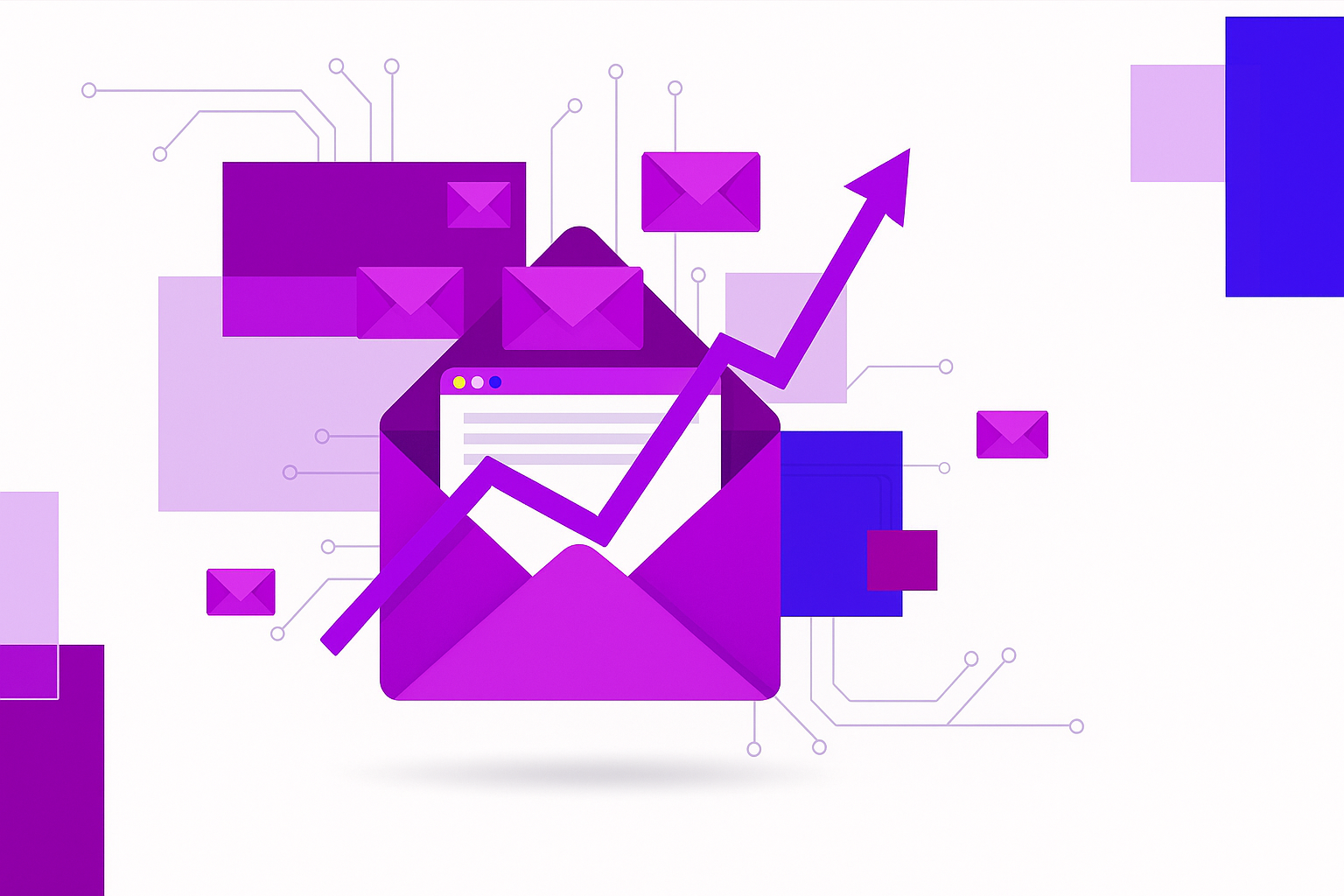Email isn’t dead. It’s just misunderstood.
While marketers chase the latest social platform or debate the merits of AI-generated content, email quietly continues to deliver the highest ROI of any digital marketing channel ($36 for every $1 spent in B2B contexts).
Yet most companies treat it like an afterthought, blasting generic messages to purchased lists and wondering why their engagement rates flatline.
Here’s the real problem: they’re optimizing for the wrong metrics.
Open rates are vanity. Click-throughs and conversions are reality. You can trick someone into opening an email with a clever subject line, but you can’t trick them into becoming a customer.
The companies winning at B2B email aren’t the ones with the highest open rates—they’re the ones building trust, delivering value, and driving actual business outcomes.
This guide cuts through the noise. We’ll show you how to build a B2B email marketing strategy that actually works, one that respects your audience, complies with regulations, and drives measurable revenue.
What is B2B Email Marketing and Why It Still Matters
B2B email marketing is direct communication with business decision-makers through their inboxes. Unlike B2C, you’re not selling to individuals—you’re navigating buying committees, corporate hierarchies, and procurement processes that can stretch across months.
The stakes are higher. The sales cycles are longer. The margins matter more.
And executives still prefer email. While consumers might ignore promotional messages, business buyers actively use email to research vendors, compare solutions, and make purchasing decisions. Your competitors understand this. The question is whether you do.
Why You Need a Documented Strategy (Not Just a Campaign Calendar)
Here’s what most B2B marketers get wrong: they confuse activity with strategy. They send newsletters, promotional emails, and product updates without understanding how these pieces fit together or drive business outcomes.
The result? Corporate spam filters catch half your messages. The other half land in inboxes but never get opened. And the few that do get opened don’t convert because you’re messaging the wrong person at the wrong time with the wrong value proposition.
B2B email faces unique challenges:
- Security filters that block legitimate business communication
- Multiple stakeholders who need different information at different stages
- Non-human interactions (gatekeepers, assistants, automated systems)
- Complex buying processes that require sustained engagement over months
A documented strategy solves these problems. It defines who you’re targeting, what value you provide, and how you measure success. Companies with documented strategies see open rates 2-3x higher than those winging it.
The data is clear: permission-based lists generate 5x more opens and 10x more clicks than purchased (or rented) lists. Quality beats quantity every time.
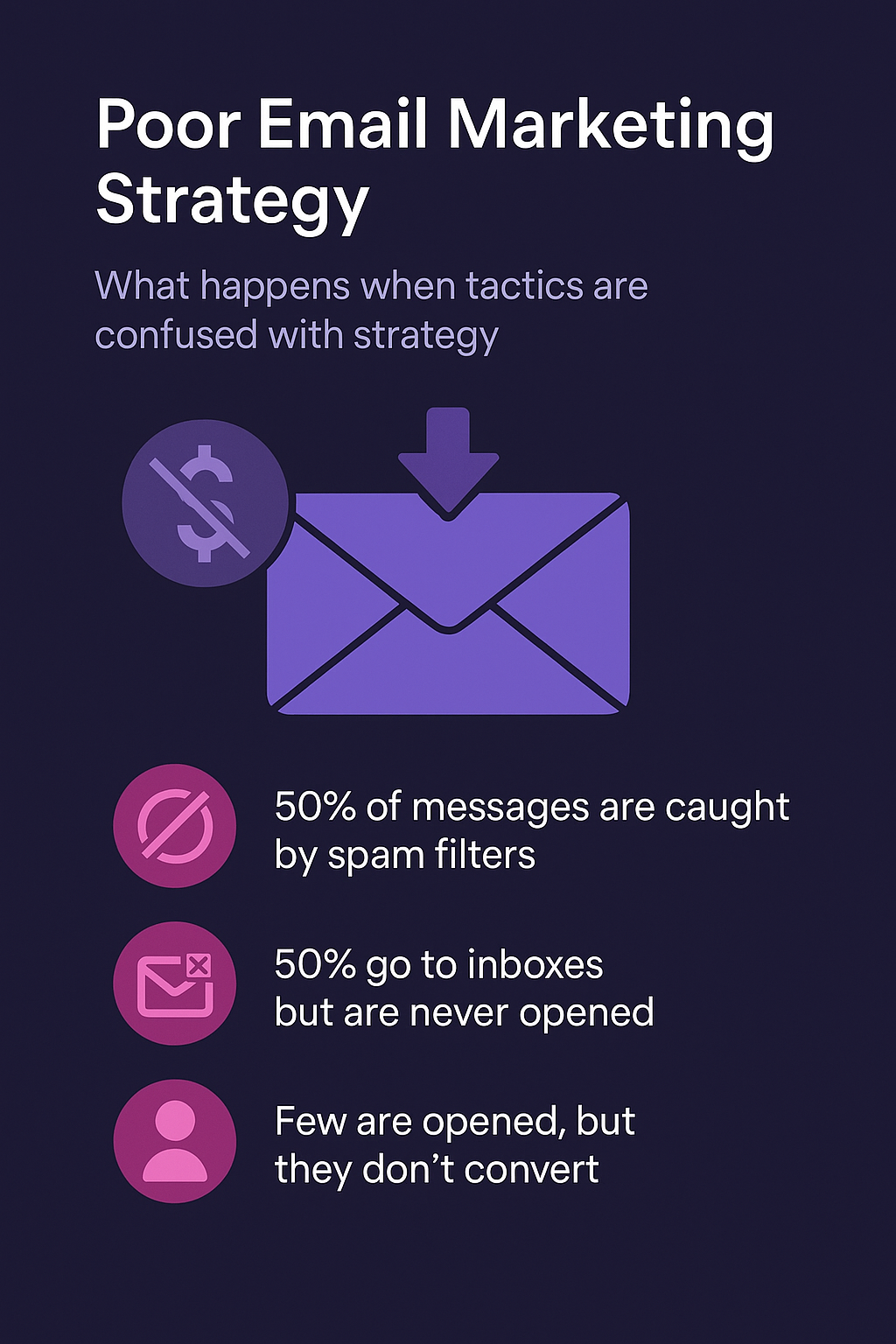
Building a High-Quality Email List That Actually Performs
Your list is your moat. It’s your foundation. Build it wrong and everything else fails.
The Non-Negotiable: Permission (But Not the Way You Think)
The traditional advice is simple: only email people who explicitly opt in. Double opt-in. Forms everywhere. Friction at every touchpoint.
Here’s the problem: that approach leaves money on the table.
B2B relationships don’t always start with someone filling out a form. They start with referrals, trade show conversations, LinkedIn connections, and existing business relationships. Waiting for explicit opt-in means ignoring legitimate prospects who would value your content.
The solution isn’t purchased lists or scraped contacts—those will destroy your email deliverability and reputation. The solution is transparent permission.
Three legitimate paths to permission:
- Express consent: Someone actively opts in through a form, content download, or subscription request. This is your gold standard (double opt-in when possible).
- Implied consent: Based on existing business relationships, referrals, or professional context where contact is reasonably expected. Common in B2B when you’re already doing business together or someone was referred to you.
- Permission pass: The middle ground that most marketers miss. You have a legitimate list (referrals, event attendees, professional contacts), but no explicit opt-in. Send an initial “permission pass” email introducing yourself, explaining what value you’ll provide, and giving a clear, easy opt-out. Those who don’t opt out have given implicit consent to continue.
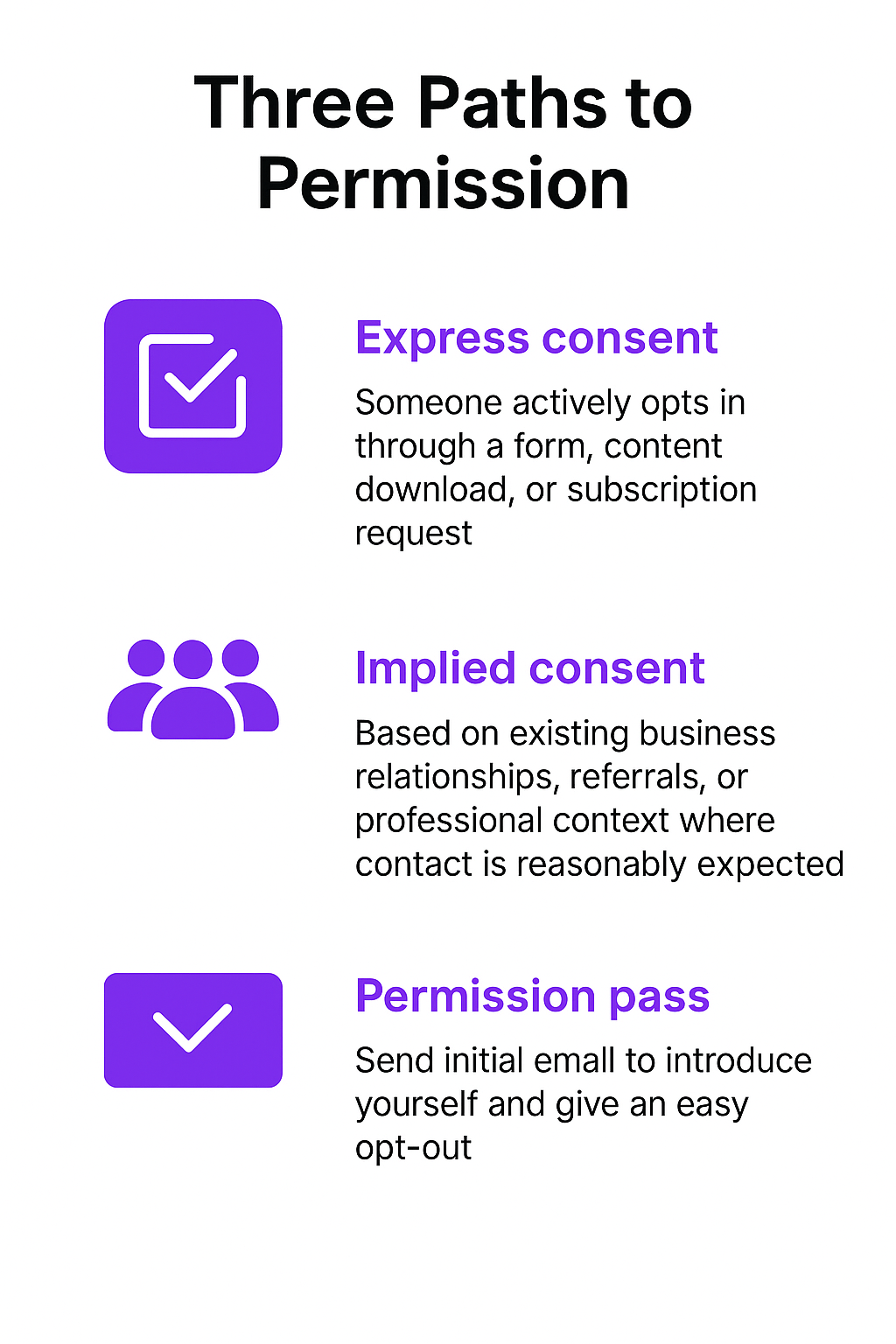
The permission pass approach respects recipients while acknowledging how B2B relationships actually form. You’re not tricking anyone, you’re being transparent about your intent and giving them control.
Document everything. Track where contacts came from, what permission basis you’re using, and when you obtained it. Compliance isn’t just about following rules, it’s also about respecting your audience.
List-Building Tactics That Work
The best B2B lists grow through value exchange:
Lead magnets that solve real problems: Industry benchmarks, technical guides, ROI calculators, compliance checklists. Create resources that decision-makers actually need.
Gated content done right: Don’t gate everything. Gate the premium stuff—the research that took weeks to compile, the frameworks your best clients use, the data they can’t find elsewhere.
Strategic partnerships: Co-market with complementary vendors. Their audience becomes your audience when you provide genuine value.
Event capture: Webinars, conferences, workshops. People who attend events are actively seeking solutions.
Clean, Clean, Clean. List Hygiene Isn’t Optional
Dead contacts kill deliverability. Remove hard bounces immediately. Soft bounces after 3-5 attempts. Unengaged contacts after 90-180 days of inactivity.
Verify email addresses at point of capture. Re-engagement campaigns can win back some dormant contacts, but know when to let go. A smaller, engaged list outperforms a bloated, inactive one every time.
Segment or Fail
Sending the same message to everyone is lazy. Segment by:
- Industry: Different sectors face different challenges
- Company size: Enterprise needs differ from SMB needs
- Job role: CFOs care about ROI; IT directors care about implementation
- Behavior: What they’ve downloaded, opened, clicked, or ignored
- Buying stage: Awareness, consideration, decision—each requires different content
The more granular your segmentation, the more relevant your messaging, the higher your conversion rates.
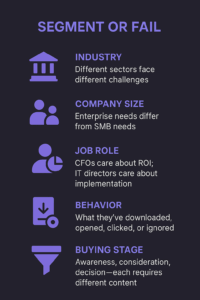
Crafting Content That Gets Read and Drives Action
Your subscribers don’t owe you their attention. Earn it.
Subject Lines That Actually Drive Clicks (Not Just Opens)
Here’s what most marketers get wrong: they optimize for opens, not clicks.
Opens are vanity metrics. Clicks drive revenue. And click-through rate starts with setting proper expectations in your subject line.
The goal isn’t to trick someone into opening. It’s to attract the right people who will actually engage with what’s inside. That means being conspicuously clear about what you’re offering.
Be specific and descriptive:
- “WEBINAR: Using AI for Productivity” beats “You won’t believe this productivity hack”
- “You’re invited: Chicago CFO Roundtable, May 15” beats “Exclusive event invitation”
- “Q3 Manufacturing Benchmarks (+ your industry ranking)” beats “See how you compare”
Notice the pattern? The good examples tell you exactly what’s in the email. No mystery. No clickbait. No false promises.
Why clarity beats curiosity in B2B:
Busy executives delete emails that waste their time. If your subject line sounds promotional, vague, or misleading, they’ll delete it without opening. Or worse—they’ll open it, feel deceived, and never trust you again.
Clear subject lines filter for qualified interest. Someone who opens “WEBINAR: Using AI for Productivity” knows what they’re getting and is more likely to register. Someone who opens “This productivity trick will blow your mind” feels tricked when they find a webinar pitch.
What clear subject lines look like:
- Lead with the format: “GUIDE:”, “WEBINAR:”, “INVITE:”, “REPORT:”
- State the specific topic: Not “productivity tips” but “Using AI for Productivity”
- Include relevant details: Dates for events, numbers for data, outcomes for guides
- Avoid hype words: “Exclusive,” “Secret,” “Revolutionary,” “Game-changing”
Test everything. What works for one segment bombs for another. But test clear variations against clear variations—not clear against clickbait.
Structure That Converts
Every email needs three parts:
Opening: Hook them in 10 seconds. Start with their problem, not your solution.
Middle: Provide value first. Industry insights, tactical advice, or data they can use immediately. Then connect it to your offering.
Close: One clear call-to-action. Not three. Not five. One. Make it obvious what you want them to do next.
Content Types That Drive B2B Engagement
Stop sending product pitches. Send:
- Industry analysis: Trends, shifts, and what they mean for your audience
- How-to guides: Tactical, specific, immediately actionable
- Case studies: Not testimonials—actual data on actual results
- Benchmarks: How they compare to peers (everyone wants to know)
- Original research: Data they can’t find elsewhere
Interactive elements increase engagement (buttons, GIFs, polls). But avoid embedded video (deliverability risk) and excessive images (spam filter trigger).
Segmentation, Personalization, and Automation: The Force Multipliers
Segmentation improves open rates by 14% and click rates by 100%. That’s not a typo.
Beyond First-Name Personalization
Stop thinking “Hi [FirstName]” is personalization. Real personalization means:
- Referencing past interactions: “Since you downloaded our CFO guide…”
- Acknowledging company context: “Given your Series B announcement…”
- Timing to behavior: Sending follow-up when they’re actually engaged
Map the Content you’re sending to the Buyer’s Journey
Different stages need different content:
Awareness: Educational content, industry trends, problem identification
Consideration: Solution comparisons, framework guides, vendor evaluation criteria
Decision: Case studies, ROI calculators, implementation timelines
Retention: Product updates, advanced use cases, expansion opportunities
Advocacy: Referral programs, case study participation, community building
Send the right content at the right stage. Pushing decision-stage content to awareness-stage prospects kills deals.
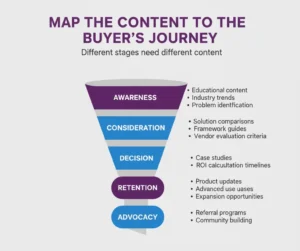
Deliverability and Compliance: The Unsexy Essentials That Make or Break You
You can write the perfect email, but if it never reaches the inbox, you’ve accomplished nothing.
Technical Requirements You Can’t Skip
Set up SPF, DKIM, and DMARC authentication. These protocols prove you’re actually you and not a spammer impersonating you. Without them, corporate email systems will block or filter your messages.
Use a reputable email service provider. Your email deliverability reputation is partially based on theirs. Cheap tools save money upfront but cost you reach.
Engagement Metrics That Matter to Email Service Providers
Email providers watch how recipients interact with your messages:
-
- Open rate: Are people interested enough to open?
-
- Click rate: Are they engaged enough to click?
-
- Spam complaints: Are they annoyed enough to report you?
-
- Unsubscribe rate: Are they done with you?
High engagement signals quality. Low engagement (or worse, spam complaints) tanks your sender reputation and triggers filtering.
List Hygiene (Yes, Again — It’s That Important)
Remove inactive contacts regularly. If someone hasn’t engaged in 90-180 days, either run a re-engagement campaign or remove them. Sending to unengaged contacts hurts your overall email deliverability.
Validate email addresses. Bounces damage sender reputation. Use validation tools to catch typos, inactive addresses, and spam traps before you send.
Mobile Optimization Is Mandatory
Over 60% of business emails are opened on mobile devices. If your email doesn’t render properly on a phone, you’ve lost over half your audience.
Test on multiple devices and email clients. What looks great in Gmail on desktop might break in Outlook on mobile.
Legal Requirements Aren’t Suggestions
GDPR (if you email EU contacts): Explicit consent, clear privacy policies, easy opt-out, data processing documentation.
CAN-SPAM (if you email US contacts): Accurate sender info, clear subject lines, physical address, obvious unsubscribe mechanism, honor opt-outs within 10 days.
Non-compliance isn’t just unethical—it’s expensive. GDPR fines can reach 4% of global revenue. CAN-SPAM violations can cost up to $53,088 per email.
Get consent. Permission pass. Make unsubscribe easy. Document everything.
Timing, Testing, and Continuous Optimization
B2B email marketing isn’t set-and-forget. It’s test-and-improve.
When to Send
Data suggests mid-week (Tuesday-Thursday) and mid-morning (10-11am) or early afternoon (1-2pm) perform best. But your audience might be different.
Test send times. Track open rates by day and hour. Let data—not assumptions—guide timing.
Trigger-based emails (behavior-driven sends) consistently outperform batch-and-blast campaigns. Someone downloads a guide? Send follow-up content within 24 hours while they’re still engaged.
Respect time zones. Sending at 10am Eastern means 7am Pacific. Segment by location and adjust send times accordingly.
What to Test (And What Actually Matters)
Test everything, but optimize for clicks and conversions—not opens.
A/B test systematically:
- CTA placement and copy: Top, middle, or bottom; button vs. link; action-oriented vs. passive language. This directly impacts clicks.
- Email content and structure: Short and punchy vs. detailed and comprehensive; where you place value propositions. Measure click-through rate.
- Subject lines: Clear and descriptive vs. benefit-driven; format prefixes (WEBINAR:, GUIDE:) vs. plain text. Track click-to-open rate, not just opens.
- Visual elements: Images vs. text-only, color schemes, layouts, button design. Measure impact on clicks, not just aesthetics.
- Sender name: Company name vs. person’s name vs. combination. Does it improve click-through rate?
- Send time: Different days, different hours—but measure by clicks received, not opens.
Test one variable at a time. Run tests on statistically significant sample sizes (minimum 1,000 contacts per variant). Give tests time to collect meaningful data—at least 24-48 hours for statistical significance.
Most importantly: declare your success metric before you test. If you’re testing subject lines, are you optimizing for opens or click-to-open rate? If you’re testing CTA placement, are you measuring clicks or conversions? The metric you choose determines which variant wins.
Metrics That Actually Matter
Most B2B marketers obsess over the wrong numbers.
Open rates are vanity metrics. They tell you who saw your subject line, not who engaged with your content or took action. You can game opens with clickbait subject lines, but you can’t game revenue.
Here’s what actually matters, in order of importance:
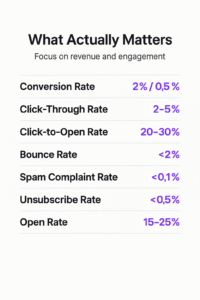
Conversion rate
What percentage complete your desired action (download, register, request demo, purchase)? This is the only metric that directly ties to revenue.
If you’re under 2% for soft conversions (downloads, registrations) or under 0.5% for hard conversions (demos, trials), something’s broken.
Click-through rate
Are people engaged enough to click? Industry average is 2-5% for B2B. Below 2% means your content isn’t compelling or your CTA isn’t clear.
This is your primary engagement signal—it shows people found value worth acting on.
Click-to-open rate
Of the people who opened, how many clicked? This tells you if your email content delivers on the subject line’s promise. Should be 20-30%.
Lower means either your subject line set wrong expectations or your content didn’t provide value.
Bounce rate
Should be under 2%. Higher signals list quality issues that will kill your deliverability. Make sure you keep your list clean and you’ll be fine.
Hard bounces (permanent failures) must be removed immediately.
Spam complaint rate
Should be under 0.1%. Anything higher means you’re damaging your sender reputation and risking blacklisting.
This is your “people actively hate your emails” metric.
Unsubscribe rate
Should be under 0.5% per campaign.
Higher means you’re sending too frequently, targeting poorly, or failing to deliver promised value.
Open rate
Yes, it still matters—but as a diagnostic tool, not a success metric.
Industry average is 15-25% for B2B. Unusually low opens (under 10%) indicate deliverability problems or subject line issues. Unusually high opens (over 40%) with low clicks suggest your subject lines are misleading.
The hierarchy is simple: conversions prove business value, clicks prove engagement, opens prove deliverability. Optimize in that order.
Don’t just collect metrics—act on them. Low clicks? Your content or CTAs aren’t compelling. Low conversions despite decent clicks? Your landing page or offer needs work. High unsubscribes? Re-evaluate frequency and targeting. High spam complaints? You’ve violated trust—stop, audit your approach, and rebuild.
The Optimization Mindset
Treat every campaign as an experiment. Document what you test, what you learn, and what you’ll try next.
The best B2B email marketing programs improve 10-20% year-over-year not through massive overhauls but through consistent, incremental optimization.
Test. Measure. Refine. Repeat.
Next Steps: From Strategy to Execution
You now have the framework. Here’s how to implement it:
-
- Audit your current program: List quality, segmentation strategy, content relevance, technical setup, compliance posture
- Build your foundation: Clean your list, implement authentication, document your segmentation strategy
- Create your content calendar: Map content to buyer stages, plan cadence, define success metrics
- Set up automation: Welcome sequences, behavioral triggers, re-engagement campaigns
- Test systematically: One variable at a time, document learnings, implement winners
- Optimize continuously: Review metrics monthly, adjust strategy quarterly, major strategic review annually
Remember: permission-based lists, meaningful segmentation, value-first content, rigorous email deliverability, and continuous testing aren’t optional. They’re the foundation of B2B email programs that actually drive revenue.
Want help implementing a successful b2b email strategy?
Outkeep can support you with a strategy to start growing your audience the right way
With transparent permission passes that respect recipients while unlocking legitimate B2B opportunities, deliverability safeguards (to keep you out of spam folders), and automated list growing with contacts that will want to read what you send.
We help B2B companies build audiences they own, not rent.
Because in B2B, your audience is your most valuable asset. Time to start treating it that way.

